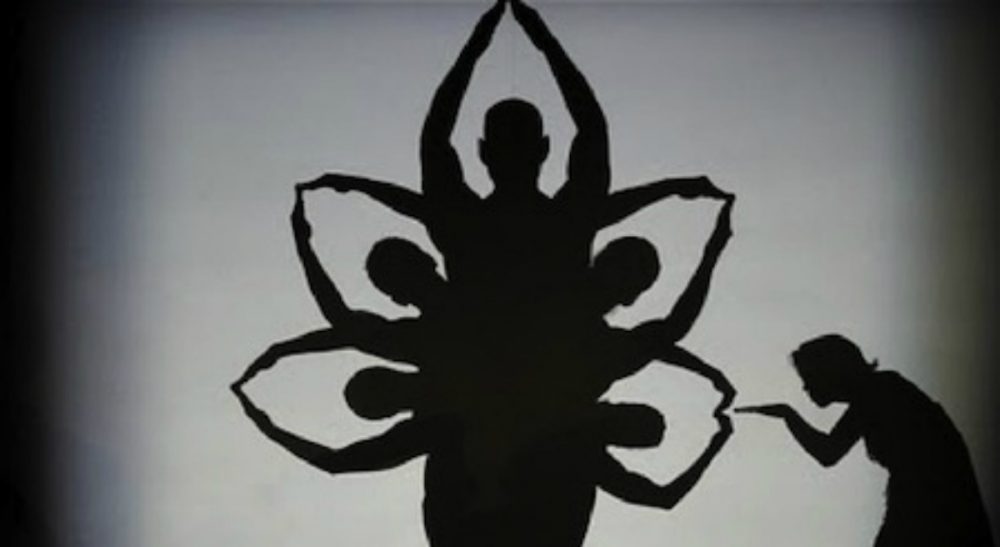Advertisement
Lead And Let Lead: Life Lessons From A Modern Dance Company

Pilobolus, the improvisational dance troupe named for a fast-growing fungus, offered a workshop in Cambridge, Massachusetts, this week. I had the privilege of participating, and I came away with the modest impression that, perhaps, Pilobolus holds the key to how humans can successfully navigate a world of divisive politics, fragmented culture and monolithic economics.
I came away with the modest impression that, perhaps, Pilobolus holds the key to how humans can successfully navigate a world of divisive politics, fragmented culture and monolithic economics.
We started by walking. Each person – there were 30 of us – in our own line, across the room. Emily Kent, Pilobolus’s education coordinator, encouraged us to spread to the edges and return, always, through the middle. Dancer Roberto Olvera, a teaching artist with Pilobolus, joined us. We walked steady, then quick, then fast. Next came Jun Kuribayashi, an artistic associate with Pilobolus, who wove through the fray, snapping photos. Somehow, we didn’t bump into one another. Yet we passed close enough that our neighbor’s breeze propelled us along.
Then we slowed down, lizard slow. Emily encouraged us to look one other in the eye, to let our gaze linger as long as our stride. She prompted half of us to go fast and half slow. We didn’t stop and count off or become two groups in any organized way. Emily simply suggested the idea of half, and we obliged.
After we were warm and knew our neighbors’ faces, we became three groups and took turns being schools of fish, moving as a unit, with self-appointed, alternating leaders. As the first group navigated the floor, the rest of us observed how they lost cohesion when they moved too fast or became stale when the cluster morphed into a line. We applauded when they spontaneously formed a circle and then broke free of it.
The second group was bolder. They expanded walking to include arm movements and dips. The visual effect of a new gesture rippling through the group was wonderful; I could see how each person related to one another. But when change was too abrupt, hesitation set in, a moment of chaos with no clear leader.
Our group went last. Emily about-faced us just before the music began, and I found myself the reluctant lead. I walked a few steps, unsure, and then turned to shed the task. Later, when our group had gathered sturdy momentum and shifted my way, I led again. This time with assurance and a bit of swagger.
Emily, Roberto and Jun gave direction with the same seamless weave in which they moved. They complemented, rather than competed, with each other. We followed their example and choreographed ourselves into a dance, executing different but related steps and postures that hadn’t existed fifteen minutes prior. I didn’t understand the whole, and I didn’t need to; I felt an integral part of our gentle grace and cohesive form.
Advertisement
I’d like to see Pilobolus lead their workshop at the United Nations, so world leaders can rediscover the power of eye contact, the energy of proximity, and how individual identities can thrive within a coherent whole.
Pilobolus performs around the country and across the globe, but I’m thinking their audience ought to include those who could use a refresher in the art – and necessity – of working together. I’d like to see Pilobolus lead their workshop at the United Nations, so world leaders can rediscover the power of eye contact, the energy of proximity, and how individual identities can thrive within a coherent whole. From there, perhaps they could go to Wall Street and illustrate the economic advantages of moving together, rather than creating a gulf between the rich and the rest. While we’re aiming high, let’s send them to the world’s most intractable zone, the Middle East, to demonstrate how communities thrive through trust rather than force. Allow the dancers to express through movement the notion that solitary commanders alone cannot summon the creative energy that evolving leadership inspires.
It’s a crazy idea, I know. But everything else we’ve tired to bring balance and equity to the world during this millennium has backfired. And Pilobolus is a very fast growing fungus, capable of spreading to unlikely places.
Related:
- Radio Boston: Teller Makes Magic At The A.R.T.
